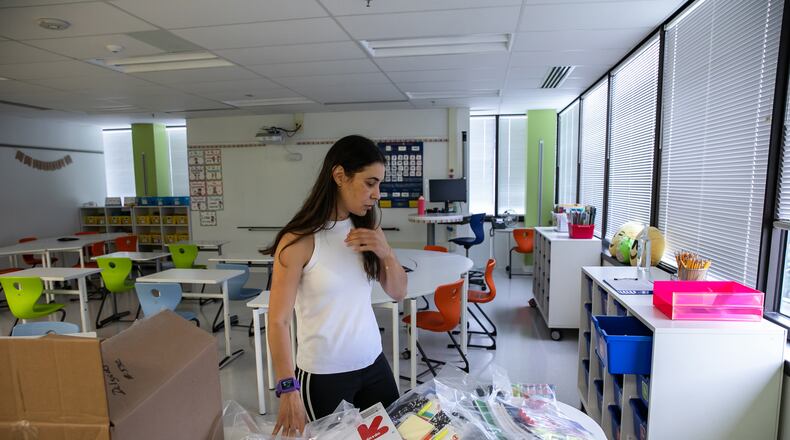WHAT YOU NEED TO KNOW
The idea of turning something built for one purpose into something else is not revolutionary or new. As buildings have been erected and economies have evolved, so too have our notions of what kinds of work can be done where: Factories have been turned into hotels and hotels have been turned into college dormitories. Malls have been adapted for all kinds of new uses. The process isn’t always easy, but it can transform vacant space, experts say.
Walking around the cavernous, three-story spa she opened last fall, Stephanie Chon isn’t shy about pointing out remnants of what used to fill this brick-walled mammoth of a building.
The windows in the massage rooms are partly frosted over to hide a view of the parking lot. A water main near the nail salon is disguised as a plant. Reflective coating obscures the drop ceiling inside the Himalayan salt room.
And tucked away from the entrance outside, there’s still a sign that points to the Northern Virginia building’s most recent tenant: “United States Securities and Exchange Commission.”
“It definitely used to be a lot stuffier in here,” Chon said as she showed off a darkened sauna filled with eucalyptus-scented fog. “Trying to convert the space was a challenge, but we made it work.”
Necessary innovation
More than three years after the coronavirus pandemic began, workers have not fully returned to once-bustling downtowns across the country. Many government officials worry that they never will, sounding alarms about how such a reality will drag down tax assessments and threaten the revenue needed to fund public services.
Cities big and small, including nearby D.C. and Alexandria, Va., have sought to address this looming crisis by trying to turn vacant office towers into apartment buildings. It’s a buzzy idea that has drawn broad support as a way to reinvent downtowns while tackling a housing crunch, too.
But it may be easier said than done, with many newer office towers lacking the sunlight or plumbing to easily carve the space into apartments.
If that’s the case, then Chon’s Balian Springs spa - and a handful of projects like it sprouting up around the country - offers one alternative that is increasingly being explored by real estate brokers and local officials: Why not turn an empty office into, well, basically anything else?
“I don’t see a silver bullet or even a series of bullets that can solve the office-vacancy crisis,” said Dror Poleg, an economic historian and the author of “Rethinking Real Estate.” Yet, he added, “now that people are working in more places and moving around more throughout the day, suddenly there is low-hanging fruit that will become relevant to fill space.”
Creative possibilities
Some possibilities are already being tested. What was once the tallest building in Portland, Ore., is being marketed as a potential home for data centers to power cloud computing. Inside a 22-story Chicago office tower across from City Hall, there could soon be a vertical farm growing tomatoes and herbs.
And closer to Chon’s Northern Virginia spa, officials in Arlington County are trying to make way for a range of potential new tenants - from breweries and podcasting studios to doggy day cares - by loosening rules that limit what can go inside empty offices without the need for a government permit.
As buildings have been erected and economies have evolved, so too have our notions of what kinds of work can be done where: Factories have been turned into hotels and hotels have been turned into college dormitories. Malls have been adapted for all kinds of new uses.
It’s a shift that can come with its own challenges: from architectural complications (How, exactly, do you replace conference rooms with distillery equipment?) and financing puzzles (Will an arcade really pay as much for a lease as a law firm?) to cultural expectations about what is supposed to go where (Shouldn’t a school be next to a grassy field?
Still, if the circumstances are right, some urbanists say, these more-unorthodox uses can help get rid of empty office space - perhaps just as well as turning those buildings into apartments.
Ryan Touhill, Arlington’s economic development director, said a “handful” of office buildings in the Northern Virginia jurisdiction - where the office vacancy rate is at a record-high 21.7% - might be poised for conversion into apartments. Everything else will require more creativity and a more multifaceted approach.
“The nature of work is continuing to evolve coming out of the post-pandemic years, and it’s an opportunity for us to think about how we use our land and what types of uses are in our buildings,” Touhill said. “Cities evolve. They’re living things, and we can’t be so stuck on one thing that worked in the past.”
From cubicles to classrooms
There are no aromatherapy rooms or saunas at Bailey’s Upper Elementary School, which occupies a five-story brick complex near a busy highway. But just like the spa down the road, this magnet school serving third- through fifth-graders was carved out of a former office building.
Longtime principal Marie Lemmon said it was all about adding more space to an overcrowded school.
When the county’s health office vacated this commercial office complex, the school system bought the property for just over $9 million. The challenge for school administrators and the architecture firm then was retrofitting the L-shaped, 96,000-square-foot building into a facility fit for grade-schoolers.
Architects put classrooms for each grade on multiple floors on the same side of the building, allowing students to move up and down through color-coordinated stairwells carved into the floor plan. Part of the surface parking lot was turned into a playground and “movement rooms” with special wooden flooring were set up for the first few years of physical education classes.
Across the real estate sector, “office-adjacent” uses - such as college classrooms, doctors’ offices or small distribution centers - could more easily replace rows of cubicles, particularly if tenants are willing to pay expensive rents. But even those projects - let alone ones that put an infinity hydrotherapy pool on the roof - could be a tough sell.
“The real estate industry really likes simple stories: ‘We get it. Something has changed. Just tell us what to do now and we’ll all run in that direction,’” Poleg said. “Unfortunately, there’s no answer like that now.”
About the Author
Keep Reading
The Latest
Featured

